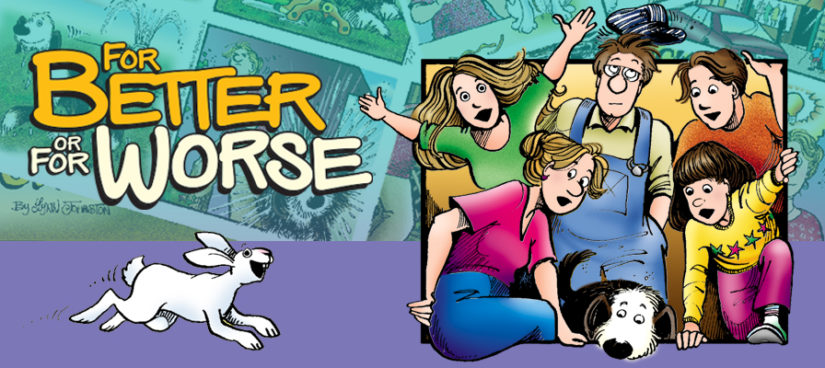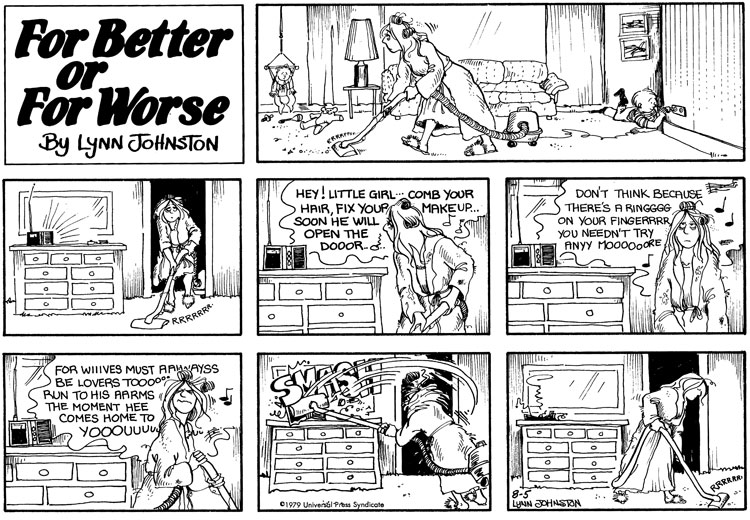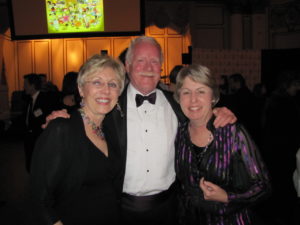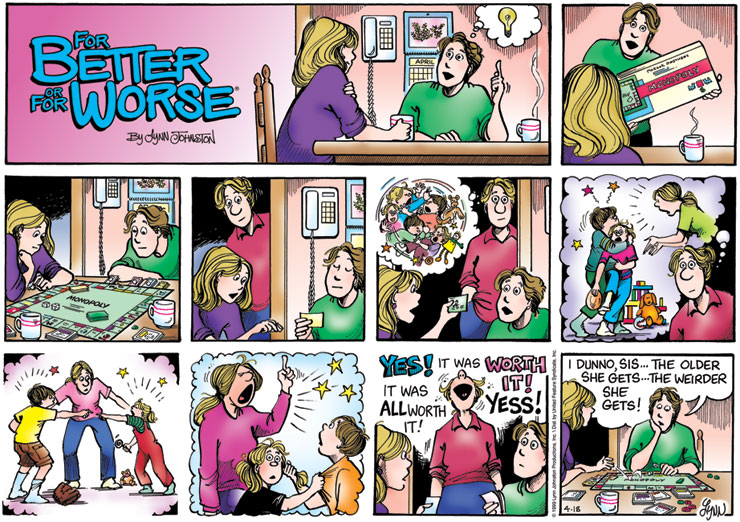
Funny for 40 years!
This month, the popular comic strip For Better or For Worse, created by Canadian Lynn Johnston, celebrates 40 years of syndication. The cartoon, which follows the Patterson family (helmed by John and Elly) and its friends, debuted in newspapers on Sept. 9, 1979.
The cartoon ran for 29 years before Johnston retired the strip in 2008, primarily due to health reasons. During its run, Johnston received the National Cartoonists Society’s Reuben Award (1985) and became a finalist for the Pulitzer Prize in editorial cartooning (1994). Today, the strip is in reprints that appear daily on GoComics and in nearly 1,000 papers throughout North America and the world. Johnston’s website features a complete archive of the strip, which contains facts, descriptions and commentary from Johnston herself, plus additional content, games and limited merchandise.
Andrews McMeel spoke with Johnston recently to reflect on and celebrate a remarkable 40 years.
One of the more distinctive elements of the strip is that the characters aged gradually over time. What was behind this decision to start aging them after the first few years of keeping them the same?
It was not a conscious decision at all; it just sort of happened organically. I found that as my own children were growing up, their vocabulary, their relationships with friends and with us and their thoughts changed and developed in a way that was so wonderful I didn’t want to lose that. And I think that if I didn’t use that, people would have missed out. In the long run, it would have been harder for me to write with the same characters and the same situations forever. I needed the storyline to make it more interesting for me as a writer instead of doing a gag-a-day. The stories never went longer than about three weeks for each little vignette.
How did you decide what topics to address within the strip, particularly the more sensitive ones? Did these come naturally as the strip developed?
I was living in a very small town when I got this job, and when you’re living in a small town you get to know everybody. We got to know the people who ran the corner store and were at church and put on the Little League games. You become very caring and perhaps more open-minded because you’re not stuck with a certain educational limit or economic background. It is everybody all thrown into a barrel.
I wanted to reflect what I knew, and so some of the stories that appeared [in the strip] happened in town but were changed to different names or circumstances. I wanted to do more than just talk about funny things. In life, funny things are there to support the not-funny things. And again, I needed the challenge as a writer. If not for the challenges, I wouldn’t have had 30 years’ worth of work.
What do you think it is about For Better or For Worse that has made it so popular with readers – and editors – all these years?
It spoke to women — that was my main reading audience at first — but eventually I was getting wonderful letters from men as well. And young families also. When I was a child, the insight that was found in cartoon art was profound, especially in Peanuts. My grandfather would read comics with me every day. The comics, for me, were more than just a laugh-a-day. Reading them was about a connection, knowing that someone else understood me.
A lot of the letters I get now are from people who read it as children and are now rereading it to their children as parents. They always comment how it’s a totally different point of view, and I love how it’s living a second life and still touching and connecting with people.

It sounds like you still receive a lot of fan mail. Do you respond to letters?
I respond to the really good ones. [In this line of work,] you get a lot of feedback that is pretty useless, but anything that is really good I do answer through my website specialist, Stephanie. Some [letters] are fabulous and [from people who] have kept in touch over the years. In talking to newer cartoonists, … I’ve asked if they responded to letters and they laughed. I told them, that’s your readership. For every one you reply to, they will tell 25 people and that’s how you grow your audience, reach more people and stay in business. Also, for me, I really wanted to connect with people and let them know that if they didn’t like what I did, I listened to them, and if they did like what I did, I thanked them.

What has been your experience working with Andrews McMeel for more than 40 years? How has your relationship with the syndicate evolved since working with editor Lee Salem for so long?
What Lee provided was confidence. As an artist, you’re putting your heart on your sleeve and putting your work out there. Coming up with comedy or worthwhile content every day is daunting. … [Lee] was funny and brilliant and a wordsmith. He helped me evolve from writing a gag-a-day to writing dialogue. He was a very big people person. He was also nonpartisan. He was a wonderful liaison between the creator and the company. He was always available; I could call him any time, even on the weekend.
[Lee] saw me through my first six months as a trial period. I hadn’t done something like this before. I’d only done a few drawings for my doctor and then a few books, which John [McMeel] got sent a copy of and took notice. And because I didn’t have a storyline or characters set up, I needed the time to create those, and Lee was my right hand through all of that. He was supportive and comforting, but beyond anything else he was smart and had respect. He was a wonderful guide in the first year of ups and downs for me. There were a few people [at the syndicate] that I didn’t get along with, and Lee was always there as a mentor and a mediator, someone who would hear you and resolve things.
When Universal approached me about rerunning the strip from the beginning, I asked if I could make some changes because you always want to make changes to your work after the fact, and I didn’t want to run the strip a second time around without that opportunity. And they were absolutely fine with that. They were wonderful about allowing me to run new materials.
The thing about the company is they’ve always been human. At one point, I moved to another syndicate, and they were only there for the bottom line and kept trying to license [the strip] into film and entertainment — big box stuff. Universal (Andrews McMeel) is different. Kansas City is different. They let you see the good side but also the rough side. They open up to you. They are human. We’ve all grown up together. I always felt like I was part of a team. I could always call Lee or Sue Roush. Even the folks at Andrews McMeel Publishing were great to work with. … It’s a company that [creators] all felt great that we worked with and signed up to work for.
[Note: Lee Salem sadly passed away on Sept. 2, 2019, prior to this interview. A tribute to Lee from Andrews McMeel Universal can be found here.]
The Embassy of Canada is hosting an upcoming exhibition of your artwork. How does it feel to be acknowledged in this way?
I don’t know the exact reason for [the exhibition], but I think it was probably suggested by [the museum curator’s] wife because she is a cartoonist. It’s serendipity that it happened on the 40th anniversary! It’s quite an honor. Now that I’ve been retired for a while it’s a surprise. When you’re in the middle of a creative career, it’s exciting and shocking to receive awards and recognition like that, and you think, I’ve got to keep it up; it’s part of the process. But when you’ve retired, you feel like everyone’s forgotten about you, so this — coming out of the blue — it’s like, oh, they still like me. It’s very nice.
[Note: “The Comic Art of Lynn Johnston” exhibition runs Sept. 13, 2019, through January 2020 at the Embassy of Canada Art Gallery in Washington, D.C. You can find more information at its website.]

How does For Better or For Worse still play a role in your life?
We do corrections and color changes. We’ll make some other editorial changes like adding seatbelts or removing cigarettes in the background. And sometimes we’ll change vocabulary, like a reference to Bill Cosby. I work at the studio on various For Better or For Worse lines, such as clothing, and I just signed a licensing agreement with a third-party company. There are basically two sides to the studio: One that does fabric designs and one that works on various things, like we’re coming out with new books — new anthologies — of the strip. That’s another thing that Universal is great about, they give me free rein.
Is there anything else you would like to add about the strip or your experience?
The loss of Lee [Salem] is definitely the end of an era. It’s very sobering and gives you time to reflect. You don’t think about these things clearly until you realize you aren’t going to see them again. We’re only a year apart and our children grew up at the same time. I’m very, very grateful for having Lee in my life and for working with a great company and for having the strip run again. I couldn’t be more rewarded and appreciative.
